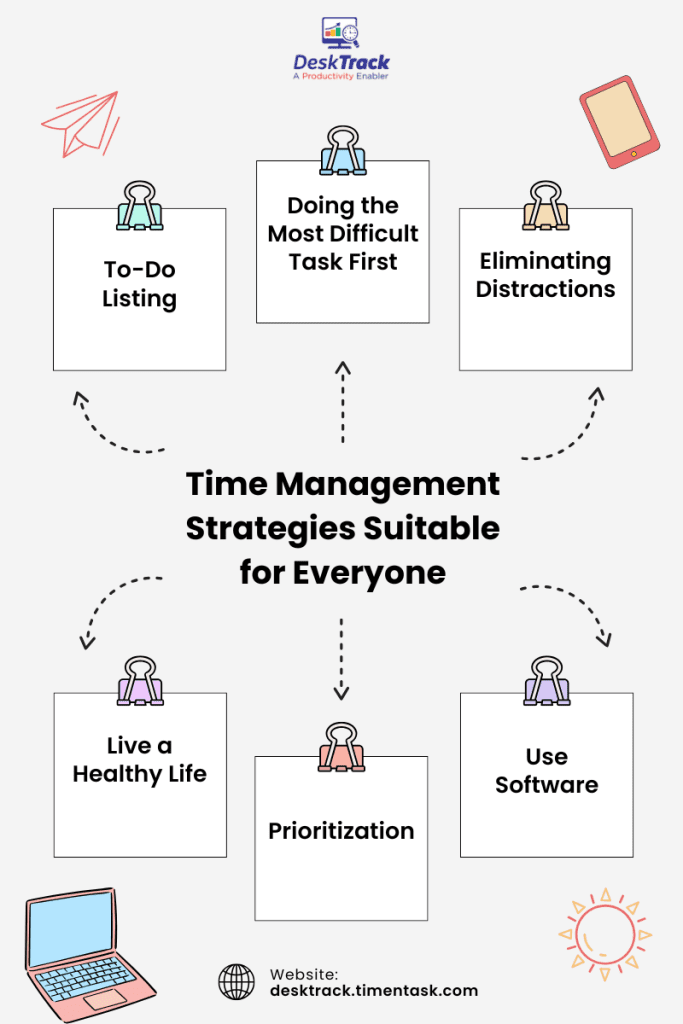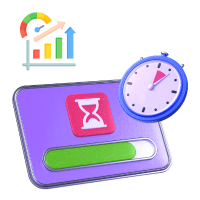
Are you seeking the ideal time management technique to suit your style? We have got you covered with not one but 26 different time management techniques and proven strategies to choose from.
Since we are not the same, we also use different methods to manage our time. The method someone else is using may or may not work for you. However, taking a 50/50 chance is a waste of your time. Moreover, not only at work, but properly managing your hours helps make your non-work life more stress-free, smooth-going, and convenient.
What are Time Management Techniques?
Simply put, time management techniques are proven methods that make it simple to manage your time and get work done without exceeding your limits. These methods have been created by experts who have tried and tested them multiple times and even simplified the techniques.
Read Also: 32 Good Workplace Habits To Incorporate into Your Daily Routine
Best 26 Different Time Management Techniques for 2025
So now, we can keep everything else aside and focus solely on the top 26 time management methods. So, what are some time management techniques? Take a pause, and let’s get started making your time management more efficient.
1. Pomodoro
Pomodoro is Italian for tomato. A great part about Pomodoro is that it works for both professional tasks and personal errands.
How it Works:
- Set a 25-minute timer
- Brake for 5 minutes.
- After the 5-minute break, it’s 25 more minutes of sweating for you.
- Repeat the 25/5 cycle 4 times.
2. Kanban
It’s one of the visual time management methods, which uses a whiteboard or board-like interface to follow your work progress.
How it Works:
- Determine the number of stages, create columns accordingly, and move your tasks across the stages.
- Keep doing this till the work is done.
3. Getting Things Done
Getting things done is a 5-step method that lets you easily brainstorm your tasks and convert them into a simple to-do list.
How it Works:
- Note every task that comes to your mind
- For each task, you need to identify whether it’s actionable and has steps you can jot down and follow.
- Categorize tasks under various labels and tags.
- Review your tasks from time to time
4. Eat that Frog
Eating frogs is all about task prioritization. You pick out your most important or worst task (frog). Only after you are done with your frog can you move on to other tasks. So, is anyone else feeling hungry, or is it just us?
How it Works:
- Prioritize and label tasks
- Task A is the most important one, which you need to do first
- Task B is the one you need to do after Task A.
- Task C is work you can do.
- Task D is delegated.
- Task E is optional.
5. Timeboxing
You allocate periods known as boxes to tasks and stop once the timer runs out. Since it often involves fixed deadlines, timeboxing is one of the methods of time management used in project management.
How it Works:
- Checklist all your workday tasks and activities.
- Define a goal for each task
- Important tasks requiring more focus get longer time brackets
- Divide difficult tasks into subtasks and allocate shorter time boxes to them.
- Complete all your tasks in sequence
- Take a break
- Review your accomplishment
- Pay attention to other time boxes in your schedule
6. Time Blocking
What you are doing here is making time blocks for particular work tasks and working on them during that time.
How it Works:
- Define and prioritize tasks and activities
- Assign each task to a time block. The length is priority-based.
- Note everything in a calendar.
- Start working in sequence.
- Schedule and take breaks
- Keep it flexible. If an urgent task arises, allocate a time block for it and work on it as soon as possible.
- If a task takes more or less time than you estimated, revise the schedule for your remaining workday.
7. Inbox-Zero
We all hate unread emails in our inbox. Right? However, we still have to face this pile every day. This time management technique deals exactly with this big issue.
How it Works:
- Determine a time for working on email management and strictly follow it
- Silence notifications.
- Prioritize your emails:
- Respond right away to emails you can answer quickly, and the most important emails.
- Paste emails that will take longer to answer into a specific folder.
- Determine the messages you can delegate, and forward them
- You delete or archive unwanted or old emails.
8. Who’s Got the Monkey
No, you don’t have to bring monkeys from zoos for this one. Nonetheless, the focus here is on task delegation for your management department. However, anyone can use it.
Here, tasks are referred to as monkeys for some reason. So, now you need to figure out how to deal with these 3 types of monkeys.
- Boss-imposed time
- Colleague-imposed time
- Self-imposed time (discretionary and subordinate-imposed)
So, finally, we have an excuse to call our bosses the monkeys they are.
How it Works:
- Figure out the task and steps required to do it
- Assign the right monkeys to the right persons
- You need to ensure that the employee appropriately handles the monkey.
- For important monkeys that don’t allow mistakes, recommend the necessary task completion steps and step in if needed.
- If you are certain, then let the person work on it.
- To ensure that everything is on track, specify when you will provide follow-up.
9. Action Method
You view and divide all your activities into different projects to manage them accordingly.
How it Works:
- Organize your events, tasks, and activities as a project.
- Divide the project into 3 categories:
- The work that you require to be done
- References are notes.
- Backburner items are ideas and plans you may work on someday.
10. The Eisenhower Matrix
Prioritize your tasks across different labels. The idea is for you to analyze each task according to its urgency and importance, and to handle them according to the matrix.
How it Works:
- List and distribute tasks into 4 categories
- Essential and urgent work needs to be done immediately
- You need to plan for when you will do important but not urgent tasks
- Delegate unimportant and urgent tasks
- Drop unimportant and unurgent tasks.
11. Biological Prime Time
Your biological prime time is the time of day when your energy levels are at their peak, so you are likely to be most productive during this time.
How it Works:
- Experiment with your work throughout several workdays. During this time, you have to monitor your energy, focus, motivation, and attention span.
- Make a chart from your results for every hour and day.
- Analyzing your outcome at the end of the time bracket will make you notice that you can do maximum work at a particular hour.
- Allocate priority tasks to that particular time only.
- Assign less important tasks to the other periods.
12. The Productivity Journal
Simply put, you have to make a to-do list here. It’s as simple as that. However, your checklist is quite detailed.
How it Works:
- Create a to-do list daily.
- Jot down the task completion hours.
- Based on the above results, you need to modify your future to-do lists.
- For more details, you can:
- Self-rate your productivity on a range of 1 to 10, task-wise.
- List your distractions to boost the probability of avoiding them.
- Divide each task on your list into subtasks
- Additionally, set goals that you wish to reach through these tasks.
- At the end of each workday, comment on:
- Tasks you have successfully finished
- The issues you faced and whether you were able to overcome them.
13. The Seinfeld Method
For this method, all you need is a calendar and a red marker. This calendar-based time management technique is great for forming a good habit or learning a new skill with consistency.
How it Works:
- Take a calendar and a red marker.
- Try to work every day. Circle the days you have worked with the marker.
- The red-circled days increase over time, forming a chain.
- The day you don’t work remains unmarked. However, it breaks the chain.
- Work every day, so you don’t break the chain.
14. The 10-Minute Rule
This method to manage time works on the concept that a stretch of 10 minutes is good for continuous work.
How it Works:
- Choose a task
- Begin working on it
- After 10 minutes, analyze your focus and patience. Identify whether you wish to continue working on this task for 10 more minutes.
- Work in 10-minute brackets until you want to halt working on it for the day.
15. To-Done List
This checklist for managing time includes all the goals that you have accomplished during the week.
How it Works:
- At the end of each work week, take your time to note down all your accomplishments.
- Next to each item, write down what you learned while working on it. Also, don’t forget to note what you can do differently next time to get better outcomes.
16. To-Don’t List
The opposite of a to-done list, the to-don’t list includes all the tasks, habits, and activities that you want to avoid doing.
How it Works:
- Make a list before the start of each workday.
- Jot down all the tasks, ideas, and habits you will aim not to do, or think about.
- Include the word don’t in front of each listed item.
- Check off all items that you managed to avoid.
17. Flowtime Technique
This time management technique is similar to the 10-minute rule. However, the timer is usually 10-90 minutes.
How it Works:
- Choose a task to work on.
- Decide to work for a particular amount of time and set the timer
- Work until the timer stops
- Decide whether you can focus on this task for some more time. If yes, set the timer for those hours.
- After this time is also up, identify whether you can continue working on it for some more time.
- At any point, when the given period runs out, liven up if you can’t concentrate on the task anymore.
18. Top Goal
Here, all you have to do is figure out your most essential objective. What you will do next is allocate time to work on it every day.
How it Works:
- Select your top goal
- Schedule 2 hours during which you will work on it daily.
- To ensure that there is no interruption, schedule to work on this objective when everyone is asleep. Also, it’s best to avoid distractions during this time.
- You must work only on your top goal during these 2 hours.
19. Pareto Analysis
Also called the Pareto Principle, this time management technique is based on the 80/20 rule.
How it Works:
- Jot down all the issues you are facing
- Find the cause behind these issues
- Assign a score to each issue. The bigger the problem, the higher the number.
- All you need to do now is group these issues based on cause and assign a score to each batch. You need to work your way around the highest-scoring groups first
20. Rapid Planning Method
Also known as RPM, it also extends to result, purpose, and a massive action plan. The idea here is to train your brain to envision what you want to achieve.
How it Works:
- Note down all the week’s work you require finishing. Note down only 5-9 tasks.
- Group similar tasks.
- Now you have to make RPM blocks. Focus on your most important area and make a block for it. There are always 3 columns:
- The first column is about the results you wish to get.
- The second column deals with why you want the outcome
- The third column is for noting down the activities that will assist you in completing your tasks and achieving the expected outcome.
21. Pickle Jar Theory
This technique for managing time is exactly as it sounds. You imagine a pickle jar. However, the pickle is made of uneatable things.
How it Works:
- Imagine a jar containing rocks, sand, and pebbles.
- The sand is the work that usually disturbs you during your workday
- The pebbles are important assignments.
- The rocks are crucial tasks that you must finish daily.
- Categorize your tasks into sand, rocks, and pebbles.
- Now, all you have to do is make a to-do list, focusing on the rocks first. Also, it is a good practice to note down the time estimates for each task, adding up to 8 hours.
22. Deep Work
Deep Work enhances your skills and creates value. The method aims to ensure that professional work is done distraction-free.
How it Works:
- It includes tasks that demand more of your energy and focus.
- You need to schedule a time for deep work. An expert tip says to schedule deep work during the time when you are the most energetic.
23. ABCDE Method
All you have to do is categorize your work into 5 blocks.
How it Works:
- Organize your tasks into 5 categories.
- A: Most important tasks
- B: Important tasks
- C: Nice to do tasks
- D: Delegation
- E: Eliminate these tasks
- Start with A and B, then you can go for C, D, and E in any order.
24. 1-3-5 Rule
The 1-3-5 rule is based on the fact that you need to manage a big task, 3 medium tasks, and 5 small tasks daily.
How it Works:
- Assign a rank to each task. Note down all your work for the day, then label each as big, medium, or small.
- Start working and complete your big tasks. Then, you can work on other tasks.
- Be flexible in your approach. When you are super busy, you will have less time to handle tasks. In such a case, making small and medium work optional is your only choice.
25. POSEC Method
POSEC means prioritizing by organizing, streamlining, economizing, and contributing. It is based on the fact that there are 5 fundamental needs, including psychological, safety, social, esteem, and self-actualization.
How it Works:
- Figure out your objectives and the time you need to do them.
- Think of all the activities in your personal and professional life.
- Identify the most efficient way to complete your work.
- You also need to economize. It includes all the activities that you enjoy doing the most.
- Lastly, help others in your community.
26. BuJo
Remember how we used to make homework copies in school? This one is similar to that. However, we are using it to monitor every second.
How it Works:
- Arrange for a notebook and a pen.
- Your BuJo includes an index page, future log, monthly log, and daily log.
- Index pages are two blank pages that contain the page numbers for the future, monthly, and daily log.
- The next two blank pages are the future log.
- Create a box for each month and add a month tag.
- The next two blank pages are titled with the name of the month is your monthly log. Your monthly task list goes on the right page.
- You will tag the next two blank pages as a daily log. All you have to do now is note down the current date and start adding your entries as tasks with a bullet dot, events with a circle bullet, and notes with a dash bullet. For crucial tasks, add an S signifier next to them.
Time Management Strategies Suitable for Everyone

With that, we are done explaining the most effective time management methodologies. However, some or all of these might be too complicated or not right as per your workflow. Not to worry. We have you covered with common strategies to manage hours.
1. To-Do Listing
Yep, the good old to-do list. Think of it like a checklist of all the tasks you need to wrap up for the day. We recommend making them digitally to save time, and also try to keep them short and sweet. Don’t forget to check off the tasks you completed at the end of the day.
2. Doing the Most Difficult Task First
Usually, we leave the most difficult tasks for last. Instead, it’s wise to do them first. Why? Because these are the tasks that require deep work and a high level of focus, which we run out of as we are near clock-out time.
3. Eliminating Distractions
Simply put, distractions waste a lot of our time. Indirectly, too, because once they are gone, it’s also tough to refocus on work. So, it’s best to eliminate them in the first place. A few things you can do include:
- Mute notifications
- Wear noise-cancellation headphones
- Stay away from gossip
- Listen to focus music
4. Live a Healthy Life
What we mean here is to have a calm mind and at least an energetic body. This will ensure that you naturally adapt your pace according to the work requirements. It’s self-explanatory. Isn’t it?
5. Prioritization
Learn to prioritize your tasks. Generally, you will do the most time-consuming tasks first and then work in order of reducing time requirements. The second level of prioritization is based on the task difficulty. However, what overrules it all is task urgency, i.e., you do the most urgent tasks first.
6. Use Software
From simple timers to advanced time tracking software, you can use whichever suits your needs to effectively manage your time.
Time Management Styles You Need to Know About

As we mentioned before, since we are all different, we have different working styles. So, we will all manage our time uniquely. So, only one method to manage time will suit each of us. Nonetheless, let’s look at these time managers real quick.
1. Time Martyr
The time martyrs will always fill their schedules with requests from others. That’s because their tasks feel like too much responsibility. They will neglect what’s important to them and jump at even the slightest opportunity to take anything else.
2. Procrastinator
Procrastinators or overthinkers are even worse. They delay anything and everything, regardless of how important it is. However, from their perspective, they work better under pressure.
3. Distractor
They don’t distract others, but can easily lose focus at any time. A random request from a colleague is as distracting as a phone call from their best friend.
4. Overestimator
These people always estimate that handling a task will take them much less time than it does.
5. Firefighter
These are people who try to do everything themselves. Overall, firefighters don’t feel fulfilled unless they are busy, working on, let’s say, 10 tasks at once. Once done, they will ask for more work. However, they have no idea that this practice will lead them to stress and burnout.
6. Perfectionist
These are the ones who have a cause behind their inability to complete tasks. Since they want everything to be perfect, they will work overtime and put in every bit of their efforts to deliver high-quality projects.
Track More Than Employee Time with DeskTrack
So, now we hope that you have finalized a time management technique for handling your personal chores and professional tasks. How convenient. Isn’t it?
However, what if you could make it automatic? That would be even more awesome. With DeskTrack, you get more than just time tracking automation.
The employee monitoring software solution provides you with real-time reports on the work-time utilization efficiency of your in-office, remote, and field employees. Maximize the efficiency, productivity, and work performance of your employees. Get DeskTrack today.
Frequently Asked Questions (FAQ)
Q. What are the 5Ps of Time Management?
Ans. The 5Ps involved in effectively managing hours are:
- Prioritize
- Plan
- Productivity
- Procrastination
- Patience
Q. What are the 7 Key Elements of Effective Time Management?
Ans. The basic steps involved in effective time management include:
- Figure out and get rid of time wasters
- Avoid perfectionism
- Get rid of procrastination
- Say no to extra work
- Identify priorities
Q. What are the Different Time Management Styles?
Ans. Here are the different styles when it comes to managing time.
- Time Martyr
- Procrastinator
- Distractor
- Overestimator
- Firefighter
- Perfectionist
Q. What are Time Management Techniques?
Ans. Simply put, time management techniques are proven methods that make it simple to manage your time and get work done without exceeding your limits. These methods have been created by experts who have tried and tested them multiple times and even simplified the techniques.
Q. What are Some Time Management Techniques?
Ans. Here are some methods of time management for you.
- Pomodoro
- Kanban
- Getting Things Done
- Eat that Frog
- Timeboxing
- Time Blocking
- Inbox-Zero
- Who’s Got the Monkey
- Action Method
- The Eisenhower Matrix
- Biological Prime Time
- The Productivity Journal
- The Seinfeld Method
- The 10-Minute Rule
- To-Done List
- To-Don’t List
- Flowtime Technique
- Top Goal
- Pareto Analysis
- Rapid Planning Method
- Pickle Jar Theory
- Deep Work
- ABCDE Method
- 1-3-5 Rule
- POSEC Method
- BuJo








